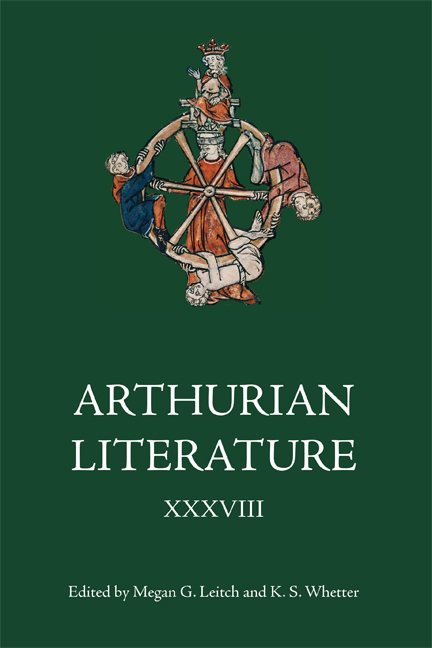Book contents
- Frontmatter
- Contents
- List of Figures and Tables
- Note on the Derek Brewer Prize
- General Editors’ Preface
- List of Contributors
- List of Abbreviations
- 1 The Inaugural Derek Brewer Essay Prize: Animals at the Feast: Strange Strangers and Courtly Power in The Wedding of Sir Gawain and Dame Ragnelle
- 2 The Kindred of a Boy without a Father: Merlin’s British Forebears and Irish Cousins
- 3 Geoffrey of Monmouth’s Subtle Subversion: Active Double- Voiced Discourse in the Historia regum Britanniae
- 4 ‘Cornwall, up in the North’: Geography and Place Names in the Source of the Old Icelandic Brut
- 5 Enacting Arthurianism in the Order of the Garter and Sir Gawain and the Green Knight
- 6 Deviants and Dissenters: Theorizing Shame and Punishment in Malory’s Morte
- 7 Loyalty and Worshyp in Conflict in Malory’s Lancelot
- 8 Emotional Inheritance in Malory’s Morte Darthur: Shame and the Lott–Pellinore Feud
- 9 Navigating and Indexing Arthurian Romance in Benoît Rigaud’s Edition of Lancelot du Lake (1591)
- 10 ‘A great many strange puppets’: Queen Caroline, Merlin’s Cave, and Symbolic Arthurianism in the Age of Reason
- 11 How Galahad Regained his Virginity: Dead Women, Catholicism and the Grail in Nineteenth-Century British Poetry
- Notes
- Miscellaneous Endmatter
10 - ‘A great many strange puppets’: Queen Caroline, Merlin’s Cave, and Symbolic Arthurianism in the Age of Reason
Published online by Cambridge University Press: 10 January 2024
- Frontmatter
- Contents
- List of Figures and Tables
- Note on the Derek Brewer Prize
- General Editors’ Preface
- List of Contributors
- List of Abbreviations
- 1 The Inaugural Derek Brewer Essay Prize: Animals at the Feast: Strange Strangers and Courtly Power in The Wedding of Sir Gawain and Dame Ragnelle
- 2 The Kindred of a Boy without a Father: Merlin’s British Forebears and Irish Cousins
- 3 Geoffrey of Monmouth’s Subtle Subversion: Active Double- Voiced Discourse in the Historia regum Britanniae
- 4 ‘Cornwall, up in the North’: Geography and Place Names in the Source of the Old Icelandic Brut
- 5 Enacting Arthurianism in the Order of the Garter and Sir Gawain and the Green Knight
- 6 Deviants and Dissenters: Theorizing Shame and Punishment in Malory’s Morte
- 7 Loyalty and Worshyp in Conflict in Malory’s Lancelot
- 8 Emotional Inheritance in Malory’s Morte Darthur: Shame and the Lott–Pellinore Feud
- 9 Navigating and Indexing Arthurian Romance in Benoît Rigaud’s Edition of Lancelot du Lake (1591)
- 10 ‘A great many strange puppets’: Queen Caroline, Merlin’s Cave, and Symbolic Arthurianism in the Age of Reason
- 11 How Galahad Regained his Virginity: Dead Women, Catholicism and the Grail in Nineteenth-Century British Poetry
- Notes
- Miscellaneous Endmatter
Summary
In 1735, an unusual building appeared in the gardens at Richmond Palace. Commissioned by Queen Caroline and built in Gothic style, the thatched cottage had an ogee-shaped doorway flanked by ornate buttresses. Visitors who ventured inside this strange construction found themselves in a vaulted circular room, on either side of which were smaller octagonal pavilions, the recesses of which contained six life-sized wax figures taken from both English history and, more interestingly, Arthurian myth. Known as ‘Merlin's Cave’, this eccentric garden monument, derided by many of its visitors, was part of a meticulously constructed and consciously symbolic iconographic programme that utilised Arthurian myth, medievalist sentiment and patriotic ideas about the native past in an attempt to consolidate Hanoverian rule. Merlin's Cave provides an example not only of Queen Caroline's political activities but of wider Hanoverian attempts to manufacture a relationship between the contemporary court and Britain's native mythologies and literatures. Such activities challenge declarations that the early eighteenth century saw the ‘Arthurian story […] vanish almost wholly from the literary scene’, or that the period should be considered an ‘Arthurian sleep’. The divided political responses to Merlin's Cave demonstrate that early eighteenth-century culture included challenges to the reverence of neoclassical literary standards exemplified by Dryden and Pope, and they confute the prevalent view among critics that ‘the legend of Arthur had finally dwindled into extinction’.3 Rather, Whiggish political sentiment combined with changing conceptions of the past to create distinctively eighteenth-century appropriations of the Arthurian mythos. I contend that Caroline's iconographic programme, delivered through Merlin's Cave, as well as literary and populist responses to it, nurtured an environment that was increasingly conducive to nascent medievalism. These developments engendered patriotic cultural associations in a period which has been construed as dominated by neoclassicism. These developments, moreover, encouraged a wider re-emergence of Arthurian romance from the mid-century onwards.
In the quarter-century prior to the Hanoverian Succession, a new kind of Arthurian literature developed. Under the Tudor–Stuart tradition, English monarchs had vindicated their titles to the English throne by tracing their lineage back to Arthur. Whereas the Stuarts’ successors established their own links to Arthur's bloodline, divisions between James I and Parliament, and subsequent dissatisfaction with Stuart assertions of Divine Right, problematised this association during the seventeenth century.
- Type
- Chapter
- Information
- Arthurian Literature XXXVIII , pp. 254 - 272Publisher: Boydell & BrewerPrint publication year: 2023



